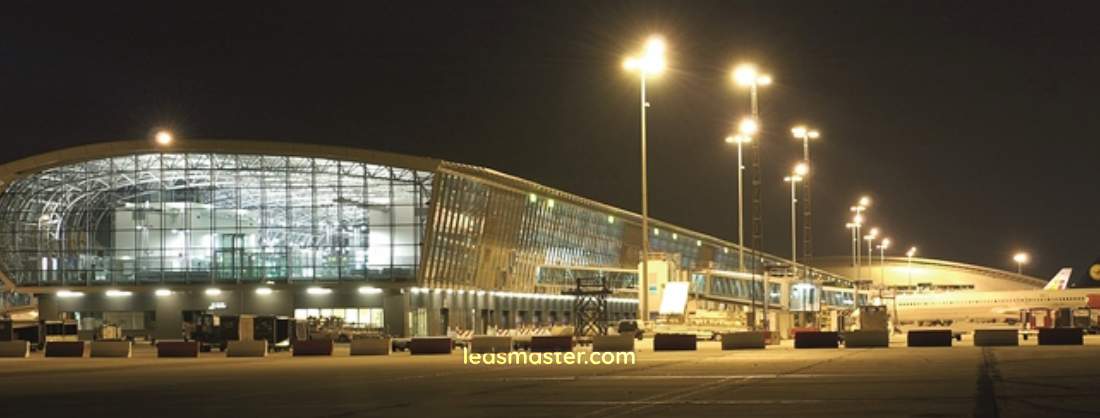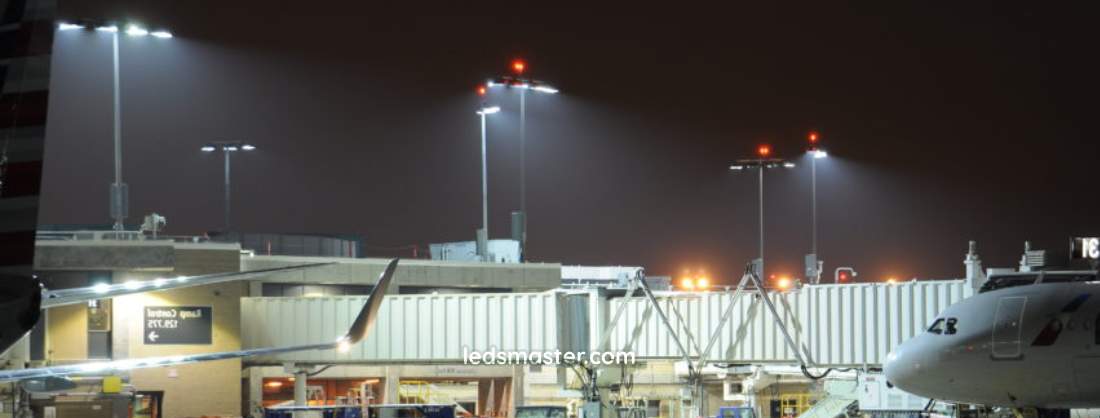Selecting the right lighting for airport aprons goes beyond mere brightness; it hinges on understanding color temperature. Measured in Kelvin (K), color temperature dictates the hue of light emitted and can dramatically influence visibility and safety during operations. The ideal range for apron lighting typically spans from 4000K to 5700K, providing a harmonious balance that enhances clarity while minimizing glare and shadows.
Get your complimentary lighting design today
By recognizing how different color temperatures influence visibility, perception, and human behavior, airport management can make informed decisions that ultimately enhance safety and operational efficiency.
Table of Contents
ToggleWhen selecting lighting for airport aprons, color temperature is a factor that influences how well activities can be conducted. Color temperature is measured in Kelvin (K), and different temperatures create different hues of light. The ideal range for apron lighting typically falls between 4000K to 5700K. This range provides a balance that enhances visibility while minimizing glare and shadows.
| Aspect | Details |
|---|---|
| Ideal Color Temperature Range | 4000K to 5700K – Balances visibility, minimizes glare and shadows. |
| Benefits of Cooler Light |
|
| Task-Specific Lighting Needs |
|
| Advancements in Lighting Tech |
|

Cool white lighting, generally associated with higher Kelvin values, is particularly effective in illuminating surfaces, making it easier for ground crews to identify markings, objects, and potential hazards. Cooler temperatures, usually around 5000K to 5700K, closely resemble daylight, which is beneficial for tasks requiring precision and accuracy. For instance, during night operations, ground personnel need to clearly see aircraft outlines, ground markings, and other important details. When the lighting resembles natural daylight, it enhances the overall clarity of the environment, allowing for more informed decision-making.
Selecting the appropriate color temperature also involves considering the specific tasks being performed. Different areas of the apron may require varying color temperatures based on the nature of activities. For example, service areas where maintenance is conducted may benefit from a cooler light that enhances visibility, while other zones may tolerate warmer lighting if the primary concern is ambiance rather than operational efficiency. Therefore, tailoring the color temperature to the operational context becomes essential.
The advancement of lighting technology, particularly with LEDs, has made achieving the desired color temperature easier. LED fixtures can be designed to produce various color temperatures, allowing for customization based on specific operational needs. Additionally, the ability to adjust color temperature dynamically in response to changing conditions can optimize lighting for different times of day or specific activities. This flexibility is especially valuable in busy airport environments where operations can change rapidly.
High-quality fixtures can provide more consistent and uniform lighting across the apron, reducing hotspots and shadows that may hinder visibility. Directional lighting is essential, as it minimizes light spill into areas where illumination is not needed, thereby reducing glare for both ground crew and pilots.
By investing in fixtures that can effectively manage and distribute light, airports can ensure that the selected color temperature serves its intended purpose without contributing to light pollution or discomfort. Proper installation and positioning of these fixtures can enhance the overall effectiveness of apron lighting, providing a safe environment for both personnel and aircraft.
The choice of color temperature has direct implications for safety and efficiency on the apron. Adequate lighting enhances the ability of pilots and ground crew to see clearly, reducing the likelihood of accidents or operational errors. Cooler color temperatures improve contrast and depth perception, making it easier for personnel to spot potential hazards, such as fuel spills or equipment left on the ground.

During nighttime operations, the challenge of visibility becomes magnified. Pilots rely on visual cues from the apron environment to navigate safely during taxiing and loading procedures. Bright, cool white lighting ensures that taxiways and aircraft parking areas are adequately illuminated, allowing pilots to make informed decisions. When lighting is insufficient, the risk of misjudgment increases, which can lead to costly accidents or even endanger lives.
Ground crew members also benefit from enhanced visibility, enabling them to carry out their tasks more efficiently. Whether it’s loading cargo, guiding aircraft, or performing maintenance checks, the right lighting conditions contribute to smoother operations. Enhanced visibility reduces the time required to complete tasks, allowing for faster turnaround times, which is crucial in the fast-paced airport environment.
The effects of color temperature extend to operational efficiency as well. When visibility is improved, tasks can be performed more quickly and accurately. This efficiency is vital, particularly when considering the high stakes of airport operations. Ground delays can lead to significant costs and inconvenience for airlines and passengers alike.
Furthermore, exposure to cooler light can enhance alertness and reduce fatigue among personnel. Studies have shown that people working in environments with cooler color temperatures tend to maintain higher levels of focus and productivity. In contrast, warmer lighting may induce a sense of relaxation that is not conducive to the high-energy demands of apron operations. By utilizing cooler color temperatures, airport authorities can foster an environment that encourages focus and attentiveness among ground personnel.
In addition to the psychological effects, the use of advanced lighting systems can further enhance the impact of color temperature on safety and efficiency. Smart lighting solutions, which automatically adjust based on real-time conditions, can ensure that the apron remains well-lit regardless of changing weather or time of day. These systems can also integrate with airport operations management software to optimize lighting according to flight schedules and activities, ensuring that resources are used efficiently.
The choice of color temperature impacts not only operational performance but also the surrounding ecosystem. One major concern in airport operations is light pollution, which can disrupt local wildlife and ecosystems. By carefully selecting color temperature and utilizing appropriate fixtures, airports can mitigate their environmental footprint.
Cooler color temperatures, particularly those in the blue spectrum, tend to scatter more than warmer tones. This scattering can contribute to light pollution if not managed properly. However, employing focused lighting designs that direct light precisely where needed can help minimize this issue. Shielded fixtures that reduce upward light distribution are essential in managing glare and light spillage beyond the apron area.
Moreover, many regions have established guidelines to limit the impact of artificial lighting on wildlife, particularly migratory birds. By selecting color temperatures that align with these guidelines and implementing smart lighting strategies, airports can operate in harmony with the surrounding environment while maintaining operational efficiency. Awareness of these regulations and proactive measures to comply with them can enhance an airport’s reputation as a responsible entity.
Sustainability is increasingly becoming a priority in airport operations. The selection of energy-efficient lighting solutions contributes to lower energy consumption and greenhouse gas emissions. LED technology has emerged as a leader in this regard, providing long-lasting performance while consuming less power compared to traditional lighting options. By integrating LED fixtures with adjustable color temperatures, airports can achieve optimal lighting conditions while also lowering their energy costs. This dual benefit aligns with broader environmental goals and contributes to the overall sustainability of airport operations.
In addition to the energy efficiency of lighting fixtures, other environmental considerations come into play during the lifecycle of these systems. Regular maintenance is necessary to ensure that lighting systems operate at peak performance, reducing waste and preventing premature replacements. Establishing a schedule for inspections and replacements helps maintain consistent lighting quality while minimizing the environmental impact associated with disposal.
The use of smart technology can also facilitate proactive maintenance, alerting airport authorities to any issues that may affect lighting performance. Such systems can track the usage patterns and lifespan of fixtures, ensuring that replacements occur only when necessary, thus further reducing waste.
Moreover, training personnel to understand the importance of lighting choices and their environmental implications can foster a culture of sustainability within airport operations. Awareness campaigns can educate staff on best practices, ensuring that everyone is on board with efforts to create a more environmentally friendly workplace.
Understanding the nuances of color temperature and its impact on apron lighting can lead to enhanced safety, efficiency, and environmental stewardship in airport operations. The decisions made regarding lighting design and implementation can significantly influence operational performance, ensuring that ground activities are conducted smoothly while being considerate of the surrounding environment.
By prioritizing the right color temperature and investing in advanced lighting technologies, airport authorities can create an optimal working environment for ground personnel while promoting safety and efficiency. As the aviation industry continues to evolve, integrating sustainable practices into lighting solutions will be essential for maintaining operational excellence and minimizing environmental impact.
Understanding the nuances of color temperature and its impact on apron lighting can lead to enhanced safety, efficiency, and environmental stewardship in airport operations. The decisions made regarding lighting design and implementation can significantly influence operational performance, ensuring that ground activities are conducted smoothly while being considerate of the surrounding environment.
By prioritizing the right color temperature and investing in advanced lighting technologies, airport authorities can create an optimal working environment for ground personnel while promoting safety and efficiency. As the aviation industry continues to evolve, integrating sustainable practices into lighting solutions will be essential for maintaining operational excellence and minimizing environmental impact.